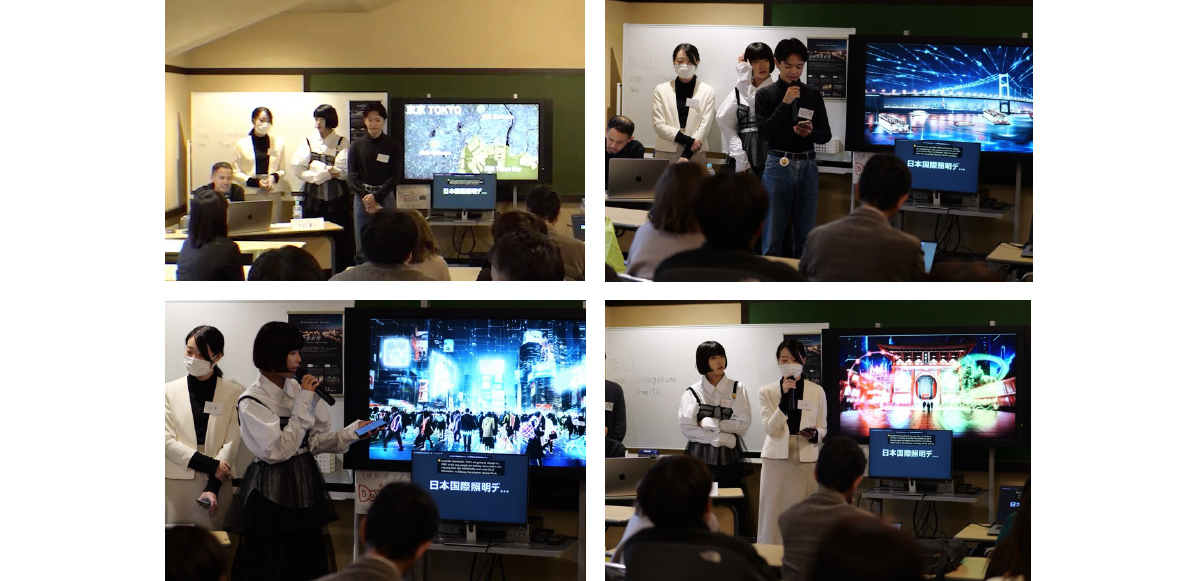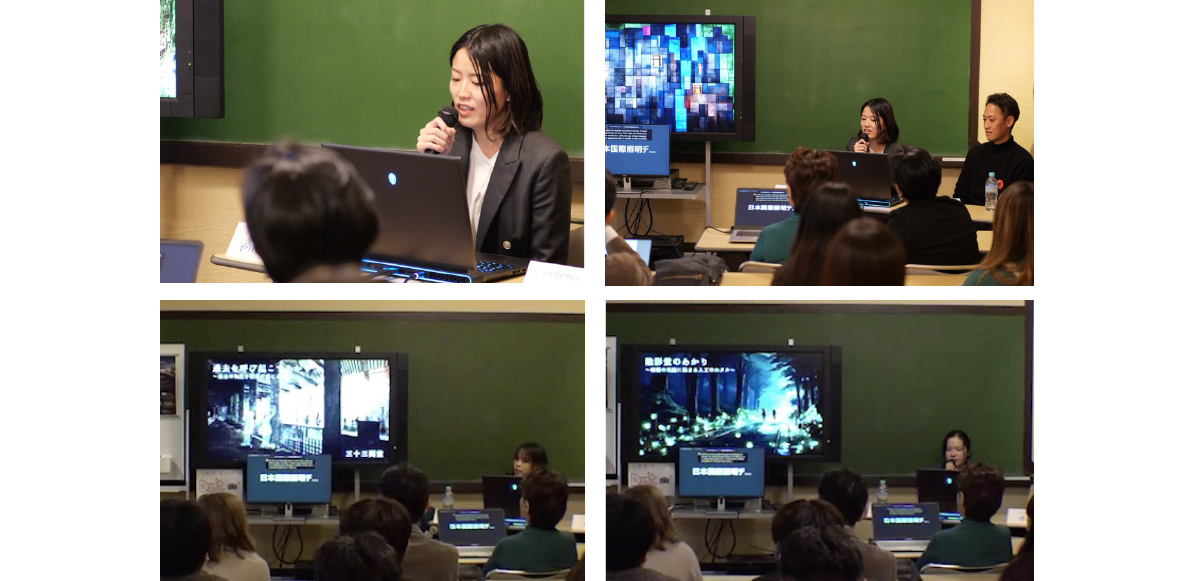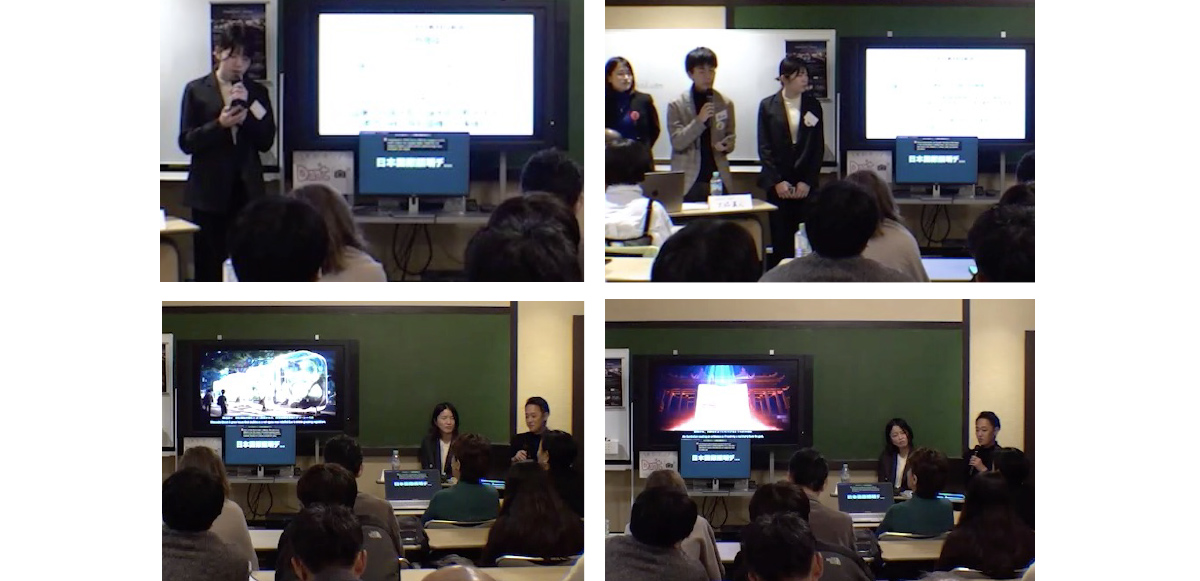Professional
【S-3】Emergence of Future Nightscapes
In this seminar, Teams of IALD member U40 (PROFESSIONAL) and students conducted fieldwork in Tokyo, Kyoto, and Fukuoka on the theme of Emergence of Future Nightscapes to study how cities and light in 2060 will change and draw nightscapes of the future based on predictions of future light events.
Following the introduction of the leaders of the three cities (Tokyo: Oyoshi, Kyoto: Takaoka, and Fukuoka: Masuda) by Director Matsushita, the seminar began as the microphone was handed over to Oyoshi, who served as the moderator of this seminar. He explained that the leaders first discussed the direction of the future creation of Emergence of Future Nightscapes and decided on the year 2060 as the target era. They then decided to use Midjourney, a generative AI, to draw imaginary pictures of future urban nightscapes through dialogue with the students who participated in the workshop.

■Tokyo
A presentation was started by the Tokyo team. They proposed future nightscapes in three areas: the Wangan (Bay), Shibuya, and Asakusa areas. The Wangan area is outlined by self-luminous plantings. Since flying cars are widely used, the flow of people is projected as the trails of light. In Shibuya, the streets are filled with the fluid and dynamic lights induced by passersby in the new fashion culture of beautifully shining light embedded in hair colors, nail colors, and textiles. In Asakusa, a black hole light that absorbs light recreates the darkness that existed when Senso-ji Temple was built, immersing people in a unique experience and emotion of darkness.


■Kyoto
The next presentation was followed by the Kyoto team, which approached a future nightscape by understanding the characteristics of the city. They proposed three types of lights based on the idea that vibes created by the contrast between “past and present,” “people and people,” and “nature and the city” are what make Kyoto intriguing. The first light, “Floating Light,” is a small particle of light that changes its shape and form to reflect the feelings and situations of each person to whom it cuddles, evoking a vibe of human interaction. The second, “Light Recalling the Past,” evokes a vibe of the past through the light projected when people want to see scenes from the old days. The third, “Light of Artificial Fireflies,” reminds us of the value and beauty of shadows and darkness through the light of artificial fireflies glowing in a cozy darkness lurking in the depths of Kyoto.


■Fukuoka
The Fukuoka team, which made the final presentation, chose three future nightscape settings: the urban area, the waterfront, and the Dazaifu historical district. Having spent extensive time carefully developing the story leading up to the act of drawing in the three workshops, the team designed the city according to the five categories: population, natural environment, energy, technology, and economy, in addition to the future. The urban area is filled with various lights, including traffic pipelines with luminous lanes, 3D holographic displays, and OLED lights, depicting a glittering attractive city. The waterfront incorporates renewable energy, where rain, plants, and light are brought together to create a lifestyle that coexists with nature. In the Dazaifu historical district, where virtual reality (VR) and physical reality merge, light technology adds life to the streetscape and culture, preserving them for the future.


At the end of their presentations, the three leaders responded to a question from Director Matsushita about the potential of the students from the perspective of the U40 lighting designers: “There was a difference in the value of what we want to leave behind for future generations, and the way they pull out information and designs” (Oyoshi); “There were a lot to gain from how they viewed not only the positive aspects but also problems and expressed severe opinions” (Takaoka); “It was a valuable lesson for me watching the students expressing their ideas without fear of age differences, something that I have not been able to do in the past.”

The seminar concluded with a positive comment from Oyoshi, that the workshop was a great success in giving the participants a sense of the possibilities of lighting by using the same tools to express the future of lighting design from the unique perspectives in the three cities.

